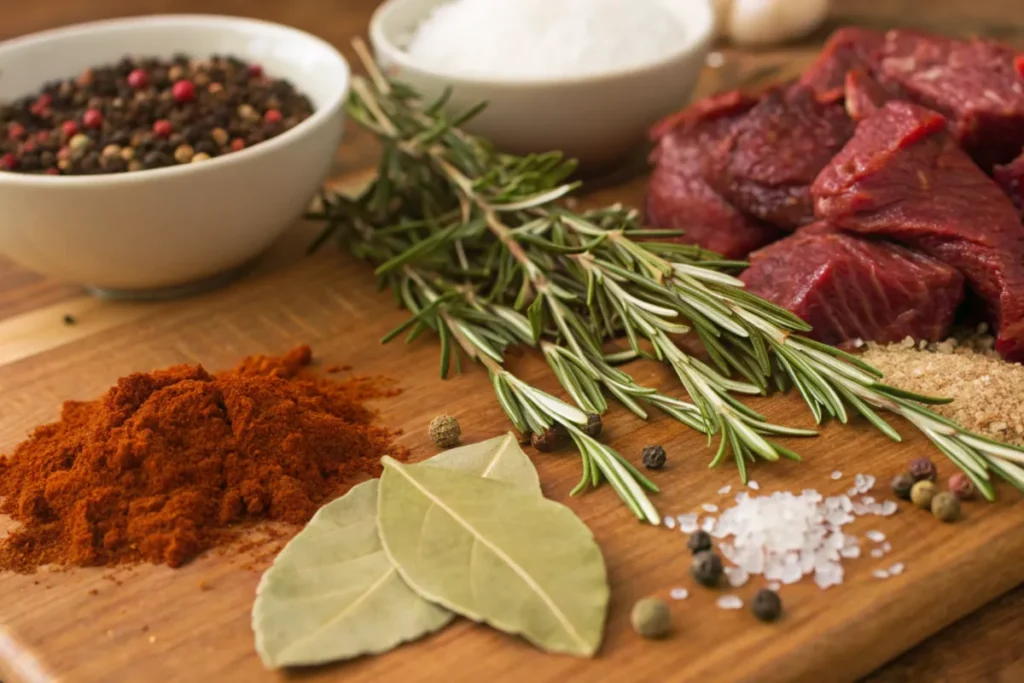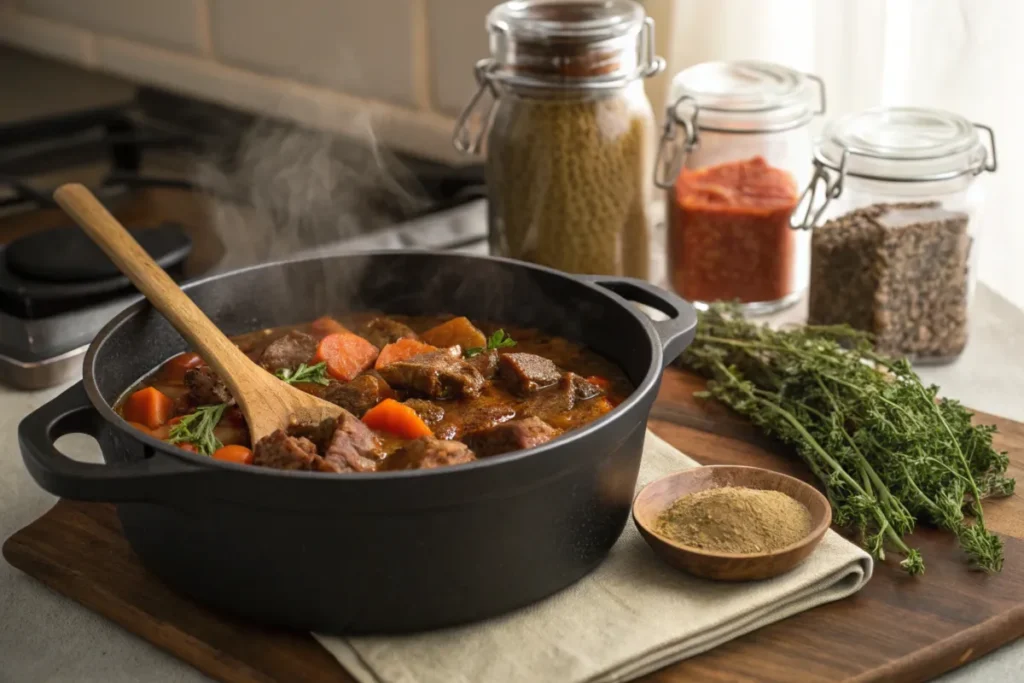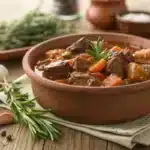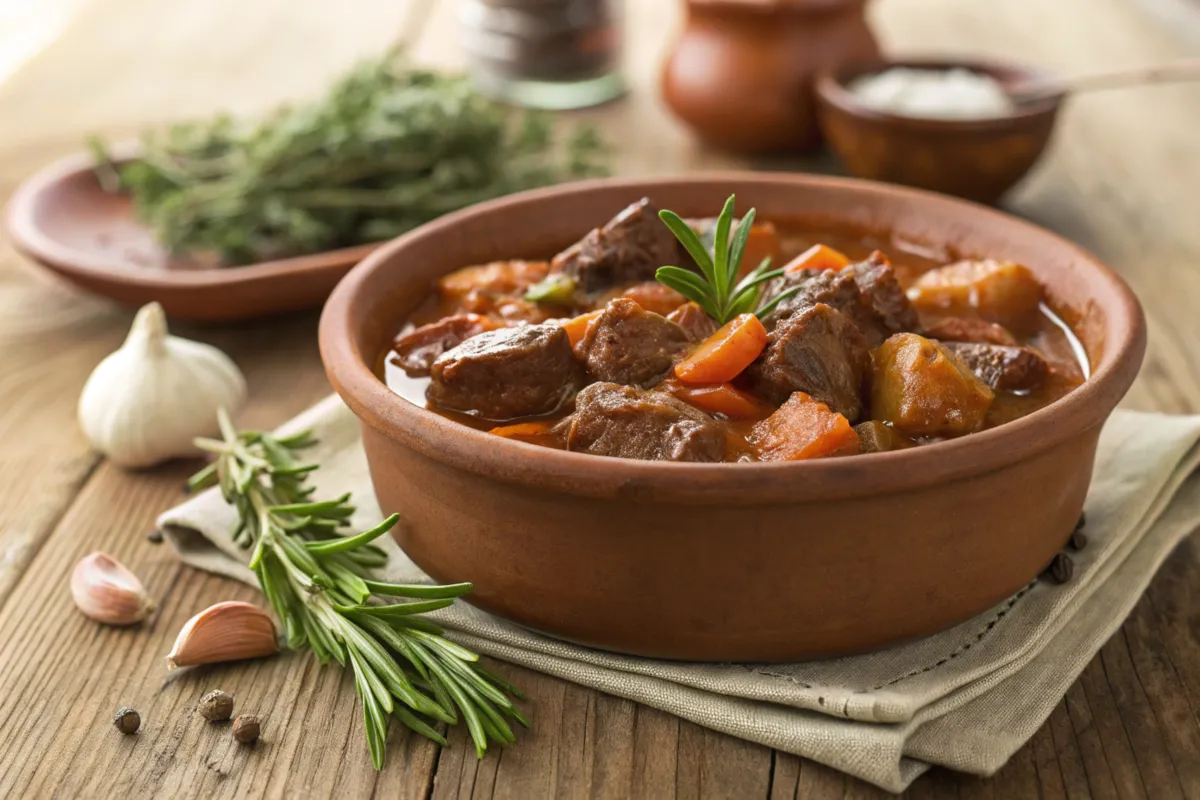Written by Sarah Miller
When it involves crafting the precise beef stew, nothing performs a more pivotal position than pork stew seasoning. The proper blend of herbs, spices, and aromatics can elevate a easy pot of stew into a heartwarming dish bursting with taste. In this article, we’ll discover the necessities of seasoning, from the pleasant components to tried-and-real cooking techniques. Whether you’re seeking to stick to conventional flavors or add a twist of your very own, this guide has you included. Ready to turn your red meat stew into a culinary masterpiece? Let’s dive in!
Understanding Beef Stew Seasoning Basics
What is Beef Stew Seasoning?
At its middle, beef stew seasoning is a carefully balanced blend of spices and herbs that complements the herbal richness of beef at the same time as complementing the other substances in the stew. Traditionally, it consists of a combination of salt, black pepper, garlic powder, and aromatic herbs like thyme and bay leaves. These substances work in concord to create a base that’s savory, earthy, and fulfilling.
But seasoning is extra than simply sprinkling spices into a pot. It’s about constructing layers of taste that broaden because the stew chefs. A nicely-pro pork stew hits all of the right notes—savory, slightly candy, and only a touch tangy, with pointers of smokiness or spice if preferred.
The Importance of Layering Flavors in Beef Stew
Seasoning isn’t a one-and-done step. To certainly grasp pork stew, you want to layer flavors at some stage in the cooking manner. This approach:
- Seasoning the beef before browning: A generous sprinkle of salt and pepper earlier than browning facilitates lock in taste and forms a tasty crust.
- Building a flavorful base with aromatics: Sauté onions, garlic, and carrots to infuse the stew with sweetness and depth.
- Adding spices and herbs gradually: Introduce herbs like rosemary, thyme, or parsley at exceptional ranges to save you them from losing their potency.
Why does layering count? It’s easy: every step deepens the complexity of the stew. For instance, browning pork doesn’t just upload a rich, caramelized taste—it additionally creates fond (the ones brown bits at the lowest of the pot), which dissolves into the stew whilst you deglaze the pan. This procedure amplifies the seasoning’s impact, making every chew an explosion of taste.
Tips for Balancing the Taste
Achieving stability is key. If the stew tastes too salty, a sprint of acid—like vinegar or tomato paste—can cut through. For a sweeter profile, try including a pinch of sugar or a touch of wine. Remember, the aim is to create a harmonious mixture wherein no unmarried element overpowers the dish.
Essential Ingredients for Beef Stew Seasoning

Key Spices for the Perfect Blend
Crafting the proper beef stew seasoning starts offevolved with choosing the proper spices. Staples like paprika, garlic powder, and black pepper form the foundation of maximum blends. These spices beautify the herbal umami of beef at the same time as supplying a diffused kick of flavor. Paprika, as an instance, lends a mild smokiness, whilst garlic powder provides intensity and aroma. Black pepper ties it all collectively with its sharp, earthy notes.
Other need to-have spices encompass onion powder, cayenne pepper, or even mustard powder for a tangy undertone. For individuals who enjoy experimenting, attempt including a pinch of allspice or cloves to infuse the stew with heat, spicy nuances. Each spice performs a unique role, so stability is prime.
Choosing the Right Herbs for Beef Stew
No beef stew seasoning is complete without herbs. Traditional choices like thyme, rosemary, and bay leaves are classics for a purpose—they supplement pork’s hearty flavor beautifully. Thyme provides a slight, lemony aroma, at the same time as rosemary brings in a woodsy, pine-like essence. As for bay leaves, their subtle floral notes create a rich, layered flavor profile as they simmer.
Fresh herbs are exquisite for completing touches, but dried herbs regularly maintain up better at some stage in lengthy cooking instances. For an unconventional twist, bear in mind the usage of marjoram or oregano, that can offer a Mediterranean aptitude on your stew. Don’t overlook to take away woody stems or bay leaves earlier than helping avoid overpowering the dish.
For extra herb and spice pairing thoughts, check out this southern cornbread recipe which uses flavorful seasonings that would encourage your stew blends.
How to Customize Your Beef Stew Seasoning
Adjusting Flavors for Different Palates
The beauty of pork stew seasoning lies in its versatility. If you decide upon a spicier kick, boom the amount of cayenne pepper or even upload crimson pepper flakes. For a sweeter undertone, do not forget cinnamon or nutmeg in small doses. Want to enhance the savory intensity? Add a sprint of Worcestershire sauce or soy sauce for an umami raise.
Regional affects also can rework your seasoning. Try smoked paprika and cumin for a Spanish flair, or go formidable with garam masala and turmeric for an Indian twist. The opportunities are countless, allowing you to cater the stew to any event or desire.
Experimenting with Aromatics and Secret Ingredients
While spices and herbs are important, aromatics take your beef stew seasoning to the next level. Begin with onions, garlic, and carrots to create a sturdy base. For an adventurous touch, stir in anchovy paste or a touch of fish sauce—these secret components deepen the taste without overpowering.
Don’t pull away from wine, vinegar, or maybe citrus zest to decorate the dish. A splash of red wine or balsamic vinegar provides acidity that cuts thru the richness of the stew, balancing the overall flavor. The secret to fulfillment? Taste as you move and permit your creativity shine.
If you’re seeking to increase your culinary skills, explore this weight watchers taco soup recipe for thoughts on taste layering and seasoning.
Cooking Techniques to Maximize Flavor

The Art of Browning and Deglazing
One of the secrets and techniques to unlocking the whole capability of red meat stew seasoning is learning the artwork of browning and deglazing. Browning the beef earlier than including it to the stew caramelizes the floor, creating a rich, savory crust that adds depth to the taste. To do this, coat the red meat lightly in flour or seasoning and prepare dinner it in a warm, properly-oiled pan till it’s golden brown. Avoid overcrowding the pan; it’s better to brown in batches.
After the pork is eliminated, the ones flavorful brown bits, known as fond, stay at the bottom of the pan. Deglazing the pan with broth, wine, or maybe water dissolves those bits, incorporating their essence into the stew. This technique amplifies the impact of the seasoning and guarantees no flavor goes to waste.
Timing and Layering of Seasonings
Adding seasonings on the right time can make all the distinction in your stew. Start by seasoning the pork early, allowing it to absorb the salt and spices in the course of browning. Next, introduce herbs and aromatics as the stew simmers. Beef stew seasoning elements like thyme, bay leaves, and rosemary thrive all through sluggish cooking, freeing their flavors regularly.
Finish the dish by way of adjusting seasonings on the quit. A splash of vinegar or a pinch of salt can enhance the stew’s stability, whilst clean herbs like parsley can brighten the taste just earlier than serving.
Recipe Recommendation
For extra thought on the use of similar strategies, take a look at out this tomahawk steak manual for recommendations on improving meat-primarily based dishes with seasoning and proper cooking techniques.
Recipes Featuring Beef Stew Seasoning
Classic Beef Stew Recipe with Homemade Seasoning
A undying conventional, beef stew is the ultimate comfort food. To prepare it, start with the aid of seasoning chunks of beef with salt, black pepper, and garlic powder. Brown the meat in batches, then sauté onions, garlic, and carrots within the identical pot. Add tomato paste for a touch of sweetness and richness, then deglaze the pan with pink wine or beef broth.
For the pork stew seasoning, combine paprika, thyme, rosemary, bay leaves, and a pinch of cayenne for a slight kick. Let the stew simmer for two–three hours, allowing the flavors to meld. The result? A hearty, flavorful dish that’s ideal for any event.
Regional Variations of Beef Stew
One of the satisfactory things approximately red meat stew seasoning is its adaptability to exclusive cuisines. Here are some local takes:
- Irish Beef Stew: Swap the wine for Guinness beer and upload potatoes and leeks for a rustic Irish twist.
- French Beef Bourguignon: Use a beneficiant quantity of pink wine, pearl onions, and mushrooms to create this French conventional.
- Moroccan Beef Tagine: Spice matters up with cinnamon, turmeric, and saffron, paired with dried apricots or raisins for sweetness.
These variations spotlight how simple tweaks to the seasoning can shipping your taste buds round the arena.
For extra delicious ideas, check out our beefaroni recipe guide for any other hearty, red meat-focused meal you’ll love.
Tips and Tricks for Elevating Beef Stew Flavor
Common Mistakes to Avoid
Even with the proper pork stew seasoning, some missteps can throw off the stability of flavors. One commonplace mistake is over-seasoning. While it’s tempting to feature more spices, an excessive amount of can weigh down the dish. Start mild, and alter regularly because the stew cooks.
Burning spices is every other pitfall. High warmth can scorch sensitive seasonings like paprika or garlic powder, leaving a sour taste. To save you this, sauté spices in short over medium heat or upload them directly to the broth. Additionally, overcooking herbs like rosemary can reason them to become too severe, so take away woody stems when they’ve infused their taste.
Pro Tips for Intensifying Flavor
To really raise your stew, recall these expert guidelines. First, use home made pork broth or inventory in preference to water. It adds richness and enhances the pork stew seasoning. For a good deeper flavor, toss in a red meat bone or marrow whilst the stew simmers.
Another trick is to allow the stew rest before serving. Cooling and reheating the dish lets in the flavors to meld and expand, making it taste even better the following day. Finally, end with a sprinkle of clean parsley or a sprint of citrus zest to brighten the dish and provide assessment.
FAQs About Beef Stew Seasoning
What Can I Add to Beef Stew for Flavor?
To beautify your beef stew, keep in mind elements like Worcestershire sauce, soy sauce, or even a splash of balsamic vinegar. These additions deepen the umami and supplement the pork stew seasoning.
Which Spices Are Good for Stew?
Staples like paprika, garlic powder, and black pepper are crucial. Herbs including thyme, rosemary, and bay leaves provide stability, even as cayenne or smoked paprika can add a touch of spice.
What Is the Best Herb for Beef Stew?
While thyme and rosemary are top alternatives, bay leaves are regularly the unsung heroes. Their subtle floral notes tie the flavors together, creating a cohesive dish.
What Is the Secret Ingredient in a Stew?
Many chefs swear via anchovy paste, fish sauce, or cocoa powder as their “secret factor.” These unlikely additions enhance the savory intensity with out standing out.
Final Thoughts
If you’re looking for different recipes to discover, check out our cottage cheese flatbread recipe for more concept.

Beef Stew Seasoning
Ingredients
For the Stew
- 2 pounds beef chunks Use stewing beef for best results.
- 4 cups beef broth Homemade is preferable for richer flavor.
- 2 tablespoons tomato paste Adds sweetness and richness.
- 1 cup onions, diced For deep flavor.
- 2 cloves garlic, minced Enhances the stew.
- 2 medium carrots, sliced Adds sweetness.
For the Seasoning
- 1 teaspoon salt Enhances flavor.
- 1 teaspoon black pepper For heat.
- 1 teaspoon garlic powder For depth of flavor.
- 1 teaspoon paprika Adds smokiness.
- 1 teaspoon thyme A classic herb complementing beef.
Instructions
Preparation
- Season the beef with salt and black pepper.
- Heat a large pot over medium-high heat and brown the beef chunks in batches.
- Remove the beef and sauté onions, garlic, and carrots in the same pot until softened.
Cooking
- Return the beef to the pot and add tomato paste.
- Deglaze the pot with beef broth, scraping the bottom for flavor.
- Add paprika, garlic powder, thyme, and bay leaf.
- Cover and simmer for 2 to 3 hours until beef is tender.
Finishing
- Taste and adjust seasoning as needed before serving.
- Remove bay leaf and serve hot.
